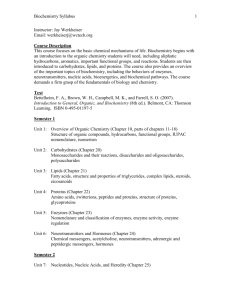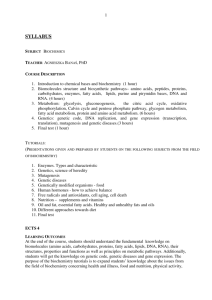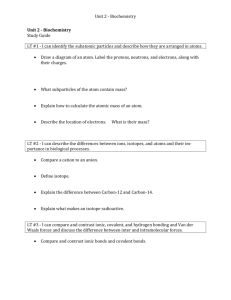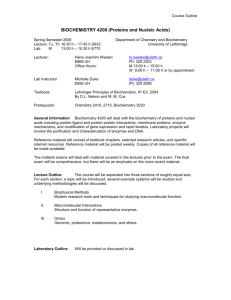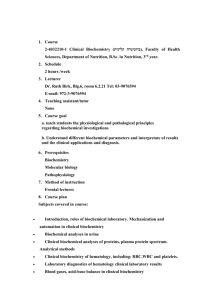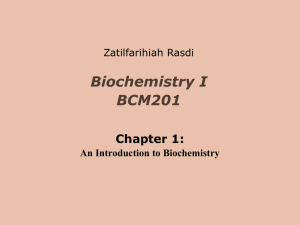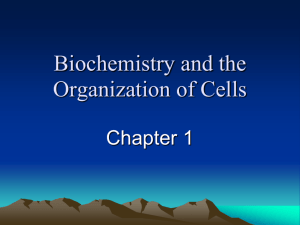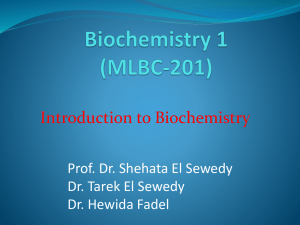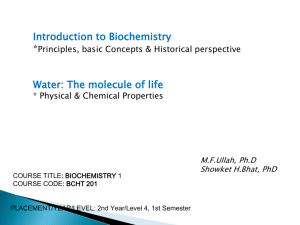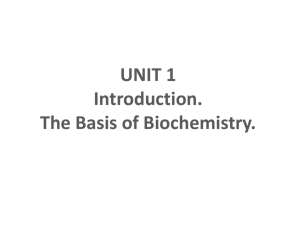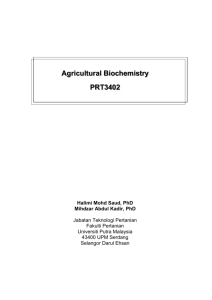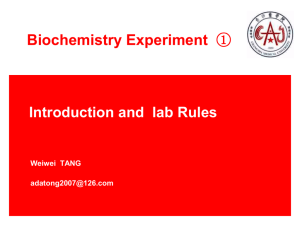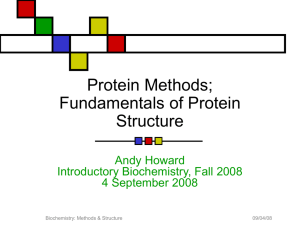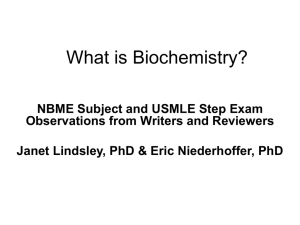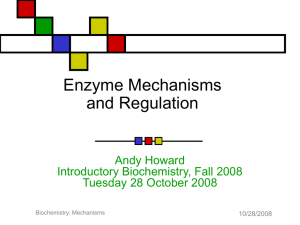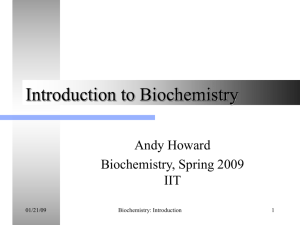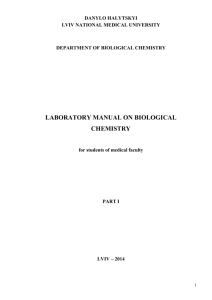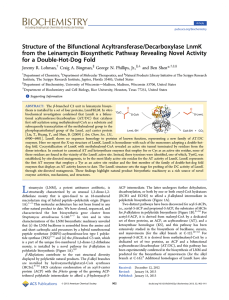Biochemistry
advertisement
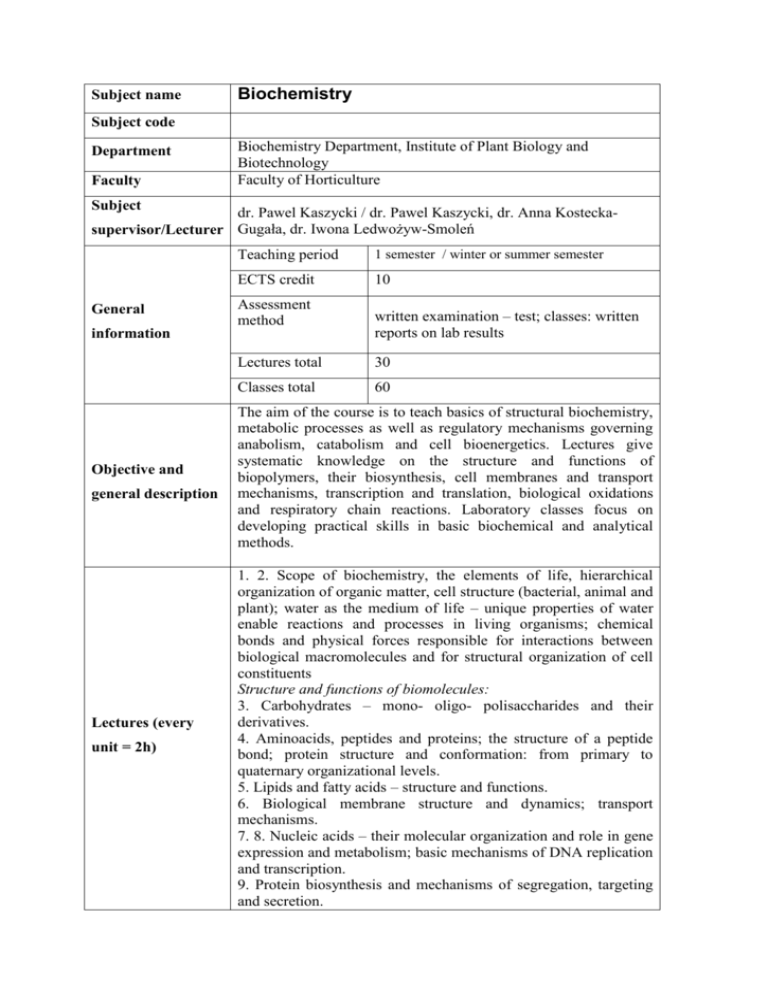
Subject name Biochemistry Subject code Department Faculty Biochemistry Department, Institute of Plant Biology and Biotechnology Faculty of Horticulture Subject dr. Pawel Kaszycki / dr. Pawel Kaszycki, dr. Anna Kosteckasupervisor/Lecturer Gugała, dr. Iwona Ledwożyw-Smoleń General information Objective and general description Lectures (every unit = 2h) Teaching period 1 semester / winter or summer semester ECTS credit 10 Assessment method written examination – test; classes: written reports on lab results Lectures total 30 Classes total 60 The aim of the course is to teach basics of structural biochemistry, metabolic processes as well as regulatory mechanisms governing anabolism, catabolism and cell bioenergetics. Lectures give systematic knowledge on the structure and functions of biopolymers, their biosynthesis, cell membranes and transport mechanisms, transcription and translation, biological oxidations and respiratory chain reactions. Laboratory classes focus on developing practical skills in basic biochemical and analytical methods. 1. 2. Scope of biochemistry, the elements of life, hierarchical organization of organic matter, cell structure (bacterial, animal and plant); water as the medium of life – unique properties of water enable reactions and processes in living organisms; chemical bonds and physical forces responsible for interactions between biological macromolecules and for structural organization of cell constituents Structure and functions of biomolecules: 3. Carbohydrates – mono- oligo- polisaccharides and their derivatives. 4. Aminoacids, peptides and proteins; the structure of a peptide bond; protein structure and conformation: from primary to quaternary organizational levels. 5. Lipids and fatty acids – structure and functions. 6. Biological membrane structure and dynamics; transport mechanisms. 7. 8. Nucleic acids – their molecular organization and role in gene expression and metabolism; basic mechanisms of DNA replication and transcription. 9. Protein biosynthesis and mechanisms of segregation, targeting and secretion. Classes References 10. Biological catalysis – enzyme structure, classes, substrate specificity, optima, structural and kinetic models of enzymatic action; regulatory mechanisms. Fundamentals of cellular metabolism regulation and bioenergetics - main anabolic and catabolic pathways and cycles and their localization within cell structures: 11. Glycolysis. 12. Tricarboxylic acid cycle. 13. Electron transport chain and oxidative phosphorylation. 14. Photosynthesis, gluconeogenesis, glycogen metabolism. 15. Pentose phosphate pathway, fatty acid catabolism. Chemical properties of biologically important molecules and biopolymers – laboratory classes are divided into blocks, each devoted to a particular group of biomolecules: saccharides and their derivates; aminoacids, peptides and proteins; lipids and their chemical components; lipid-soluble vitamins; nucleic acids and biologically-relevant organic acids; enzymes and co-enzymes, water-soluble vitamins; plant secondary metabolites. 1. Alberts B. et al. Essential Cell Biology, 2nd edn., Garland Science, LLC, 2004 2. Mathews, Van Holde, Ahern, Biochemistry, 3rd edn. The Benjamin/Cummings Pub. Com. Inc, 2001, CA. USA. 3. Avers C.J., Molecular Cell Biology. The Bejamin/Cummings Pub. Com. Inc, 1986 CA. USA. 4. Garret R. & Grisham Ch., Biochemistry. 2002 5. Lehninger A.L. Biochemistry 4th edn., W.H. Freeman, 2005


